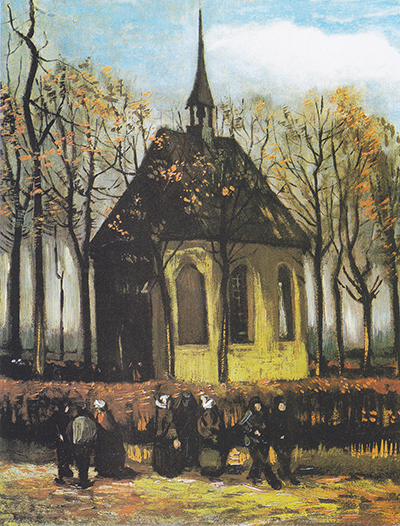Congregation Leaving the Reformed Church at Nuenen is an oil on canvas painting measuring 41.5cm by 32.2 centimetres. Vincent Van Gogh made the image on January/ February 1884.
It was later modified in late 1885. The paintwork was done in the Netherlands, at a tiny village known as Nuenen, located at North Brabant.
Van Gogh made various paintings, some displaying the local peasants, the church and numerous self-portraits. Congregation Leaving the Reformed Church at Nuenen is among his most famous pieces of art. Vincent was inspired to make the painting for his mother because she was bedridden resulting from a broken leg. The theme of this painting was inspired by the Dutch Reformed Church, where Van Gogh’s father served as a pastor.
The image portrayed the church with hedge and bare trees. When he first sketched the picture, it included a peasant holding a spade in the foreground. Later in 1885, a congregation who wore mourning clothes as a way to remember his father who had passed away earlier that year was added. He also added some leaves to the bare trees he had earlier painted.
On December 7th 2002, two of Van Gogh’s paintings were stolen at Van Gogh Museum by Octave Durham and Henk Bieslijn. The two were; Congregation Leaving the Reformed Church in Nuenen, and Beach at Scheveningen in Stormy Weather. Van Gogh had painted both before he chose his signature style. The latter is interesting since it is neat and skilfully painted.
It represented the seaside and was inspired by the artist’s stay at The Hague. The pieces went missing for more than 13 years. They were discovered at Castellammare di Stabia, near Staples in January 2016, although they did not have their original frame. They were taken back to the museums and put on display In March 2017.
Artists and Paintings Inspired by Vincent van Gogh
Vincent Van Gogh made numerous portraits of himself that have given the world an idea of the facial appearance and enigmatic character of the artist. During his lifetime, many artists made portraits that were inspired by Van Gogh. Lucien Pissarro, for instance, was Vincent’s friend who took time to observe him. The facial expression and body language of Vincent in Pissarro’s paintings display the complicated nature of Vincent Van Gogh. They show a dogmatic person who was still commended by people for his incredible talent and skill. To-date, numerous artists inspired by the works of Van Gogh have applied technology to come up with contemporary paintings done by him.




